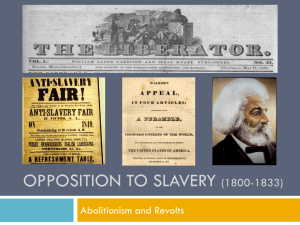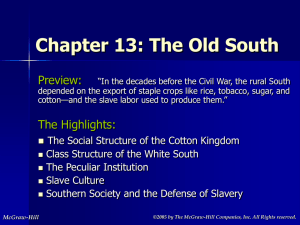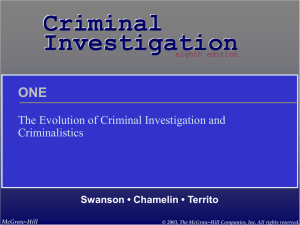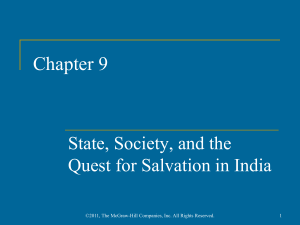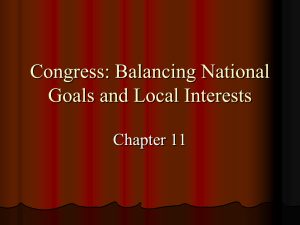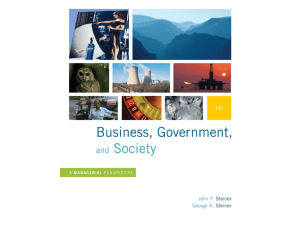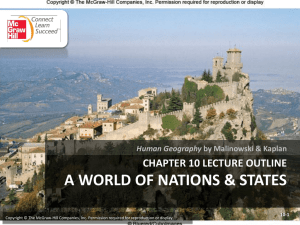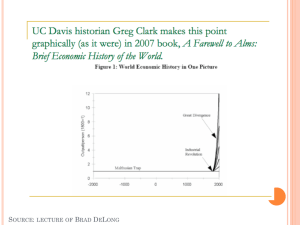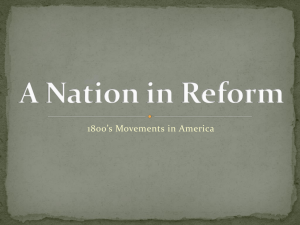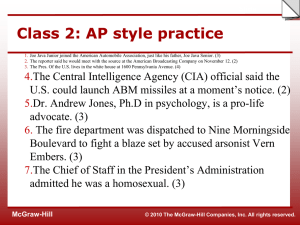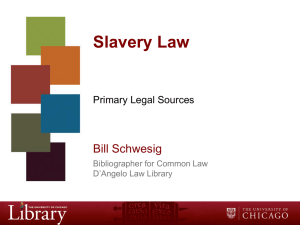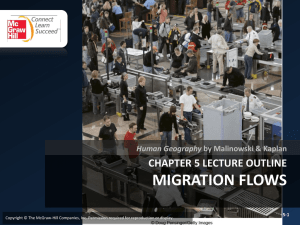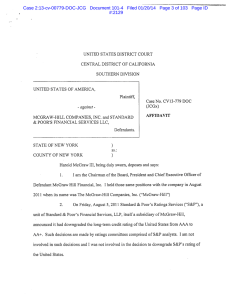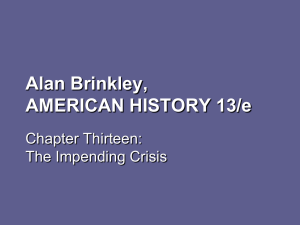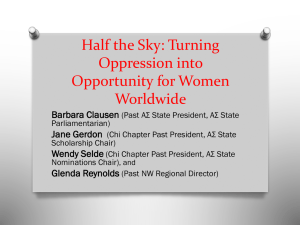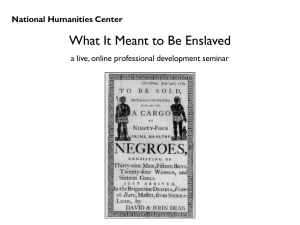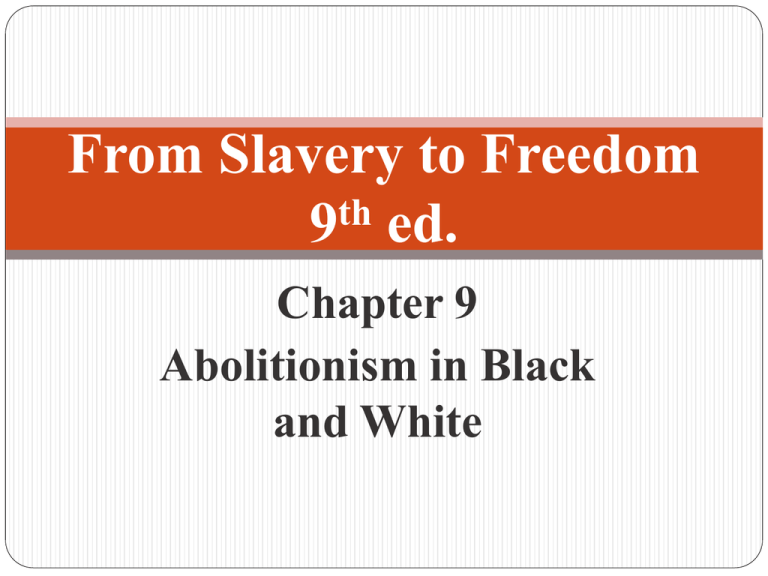
From Slavery to Freedom
th
9 ed.
Chapter 9
Abolitionism in Black
and White
Abolitionism in Black and White
Abolitionism in Black and White
Three events that heralded age of militant
abolitionism:
1829 publication of David Walker’s Appeal
1831 publication of the inaugural issue of William
Lloyd Garrison’s newspaper, The Liberator
1831 insurrection of Nat Turner
2
© 2010 The McGraw-Hill Companies, Inc. All Rights Reserved.
Black Abolitionists
Black Antislavery Societies
In 1820s, 50 black-led antislavery societies
operated in various cities
In 1830, blacks held first national convention
issuing denunciations of colonization and slavery
After publication of The Liberator, black
abolitionists aligned with Garrison
Blacks participated in 1833 establishment of the
American Anti-Slavery society
Also worked at local and regional antislavery
organizations
3
© 2010 The McGraw-Hill Companies, Inc. All Rights Reserved.
Black Abolitionists
Women Abolitionists
Women in many cities formed their own
antislavery organizations
Addressed abolition and gender issues
Many male abolitionists opposed female
officeholders in prominent male-run societies
Black Agents
Blacks worked as agents and speakers for
various societies
Frederick Douglass
4
© 2010 The McGraw-Hill Companies, Inc. All Rights Reserved.
Sojourner Truth
5
© 2010 The McGraw-Hill Companies, Inc. All Rights Reserved.
Black Abolitionists
Newspapers
African American newspapers aired debates and
ideas of black community
Freedom’s Journal – first black newspaper
Most popular black abolitionist paper The North
Star, founded by Frederick Douglass and Martin
Delany in 1847
6
© 2010 The McGraw-Hill Companies, Inc. All Rights Reserved.
Mary Ann Shadd Cary
7
© 2010 The McGraw-Hill Companies, Inc. All Rights Reserved.
Antislavery Agendas
Antislavery Agendas
Abolitionism closely connected to religious
revivalism
Argued that slavery contrary to Jesus’ teaching of
universal brotherhood
The Abolitionist Argument
Abolitionists argued that slavery:
Was against fundamental principles of American life
Was economically unsound
Threatened culture of and civilization of the South
Threatened peace and safety of country
8
© 2010 The McGraw-Hill Companies, Inc. All Rights Reserved.
Antislavery Agendas
Colonization movement was strongest among
slaveholders in Upper South
White abolitionists and blacks realized colonization
buttressed slavery
The Crusade
Throughout 1830s, abolitionist cause grew,
moving beyond the borders of the Northeast
Theodore Dwight Weld
Oberlin College
9
© 2010 The McGraw-Hill Companies, Inc. All Rights Reserved.
Antislavery Agendas
The American Anti-Slavery Society
Cofounded by Dwight Weld, Arthur Tappan, and
William Lloyd Garrison in 1833
Differences between Garrison and Tappan arose
Garrison did not think society pressed hard enough for
abolition; critical of unwillingness to work for
women’s equality
New York faction under Tappan broke away and
formed rival American Foreign Anti-Slavery Society
focusing only on slavery issues
1840 splinter group, the Liberty Party, formed in
attempt to bring abolition into electoral politics
10
© 2010 The McGraw-Hill Companies, Inc. All Rights Reserved.
William Lloyd Garrison
11
© 2010 The McGraw-Hill Companies, Inc. All Rights Reserved.
Antislavery Agendas
Black vs. White Abolitionists
Black abolitionists angered by whites’ lack of
support for true racial equality
White abolitionists uncomfortable with black
convention movement
Black-White Cooperation
White abolitionists important benefactors of
nineteenth-century African American artists
Friendships developed between black and white
abolitionists
12
© 2010 The McGraw-Hill Companies, Inc. All Rights Reserved.
Proslavery Backlash
The Proslavery Argument
Southerners promoted idea that slavery was a
“positive good”
Four main arguments of proslavery theorists
Blacks biologically and mentally inferior, a different
species of humanity
Necessity of slave labor for rise of civilization and
economic development of South
Blacks destined by history to subordinate position in
society
Slavery divinely ordained
13
© 2010 The McGraw-Hill Companies, Inc. All Rights Reserved.
Proslavery Backlash
Defending the Institution
Antislavery rhetoric prohibited in the South
Willing to use force to keep abolitionists out of
communities
Proslavery leaders went to North to pursue
runaway slaves, spread proslavery doctrine, and
spy on abolitionists
14
© 2010 The McGraw-Hill Companies, Inc. All Rights Reserved.
Proslavery Backlash
Persecution and Violence
Conflict between two sides led to harassment and
violence
Conflict over abolitionist views occurred in the
North as well
New York journalists warned of the threat of the
abolitionist “amalgamation”
Abolitionists frequently target of violence
1836 southern congressional leaders adopted a rule to
table all petitions against slavery (“gag rule”)
15
© 2010 The McGraw-Hill Companies, Inc. All Rights Reserved.
Proslavery Backlash
Changing Attitudes
Violence and gag rule backfired
Late1840s northern whites began to see slavery as
threat to liberty; 1850s political opponents of slavery
began to win elections
16
© 2010 The McGraw-Hill Companies, Inc. All Rights Reserved.
The Black Response
Black Counterarguments
Frederick Douglass – “oneness of man”
James McCune Smith
Black Narratives
Ex-slave writers were influential in refuting the
notion that slaves were happy and content
Black Literature
Quality and quantity of black literature disproved
charges of innate inferiority of blacks
17
© 2010 The McGraw-Hill Companies, Inc. All Rights Reserved.
The Underground Railroad
Origins
Started as network of antislavery activists
General Thomas Boude refused to give mother of his
slave Stephen Smith back to her mistress
Town of Columbia, Pennsylvania decided to champion
cause of fugitive slaves
Number of slaves reaching freedom via the
Underground Railroad unknown
Intensified resentment of slaveholders toward
the North
18
© 2010 The McGraw-Hill Companies, Inc. All Rights Reserved.
Robert Duncanson,
View of Cincinnati, Ohio
19
© 2010 The McGraw-Hill Companies, Inc. All Rights Reserved.
The Underground Railroad in
the nineteenth century
20
© 2010 The McGraw-Hill Companies, Inc. All Rights Reserved.
The Underground Railroad
Railroad Operations
Most operations took place at night
Slaves prepared by taking supplies from masters
and often disguising themselves
Early days, mostly on foot; as it grew, used
covered wagons, closed carriages
“Stations” were planned where fugitives could
eat, rest, and hide; news went out of their
pending arrival via the “grapevine telegraph”
All Underground Railroad lines led to free states
21
© 2010 The McGraw-Hill Companies, Inc. All Rights Reserved.
The Underground Railroad
Resources
Abolitionists raised funds required for the
substantial material resources necessary
Had many active workers
John Fairfield
Black Conductors
Underground Railroad relied on many black
conductors
22
© 2010 The McGraw-Hill Companies, Inc. All Rights Reserved.
The Underground Railroad
Harriet Tubman
Using money from her work as a domestic
servant, she left the North fourteen times to bring
family and other slaves to freedom
After fugitive slave laws passed, she preferred
bringing slaves to Canada
Jermain Loguen
Minister and stationmaster of the Underground
Railroad in Syracuse, New York
Openly denounced the Fugitive Slave Law
23
© 2010 The McGraw-Hill Companies, Inc. All Rights Reserved.
Harriet Tubman
24
© 2010 The McGraw-Hill Companies, Inc. All Rights Reserved.
The Path to Civil War
The Path to Civil War
Expansion of slavery central to turmoil that led
up to the Civil War
Fugitive slaves also highly controversial
The Compromise of 1850
Included stringent fugitive slave law, but
admitted California into the Union as a free state
Under new fugitive slave act, owners of escaped
slaves intensified manhunts; many slaves
returned, others increasingly feared capture
25
© 2010 The McGraw-Hill Companies, Inc. All Rights Reserved.
The Path to Civil War
The Christiana Riot
Effort to thwart capture of four runaway slaves
ended in death of plantation owner who was
looking for the slaves
“Jerry Rescue” – mob of abolitionists rescued a
fugitive slave who was apprehended in Syracuse
The Sectional Truce Unravels
Publication of Uncle Tom’s Cabin
26
© 2010 The McGraw-Hill Companies, Inc. All Rights Reserved.
The Path to Civil War
Passage of Kansas-Nebraska Act
Repeals Missouri Compromise; allows territories to
decide if they want to be a free or slave state
North and South struggle for control of Kansas
Galvanized leaders into political action; antislavery
Republican Party is formed
The Dred Scott Decision
Slave who accompanied master to free state
sued, claiming his residence on free soil had
liberated him
27
© 2010 The McGraw-Hill Companies, Inc. All Rights Reserved.
The Path to Civil War
Supreme Court held Scott was not a citizen and
therefore could not bring suit in the courts
Also held that Congress could not ban slavery in
federal territories and that free blacks could never be
citizens
The Appeal of Force
Black community began to see force as both
necessary and inevitable
28
© 2010 The McGraw-Hill Companies, Inc. All Rights Reserved.
The Dred Scott Case
29
© 2010 The McGraw-Hill Companies, Inc. All Rights Reserved.
The Path to Civil War
John Brown’s Raid
Plan to attack slaveholders and liberate slaves
Seized federal arsenal in Harper’s Ferry; quickly
overwhelmed by federal and state troops
Raid terrified the South; moved toward military
preparedness
John Brown convicted and hung to death
30
© 2010 The McGraw-Hill Companies, Inc. All Rights Reserved.

